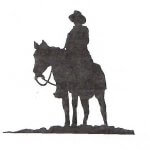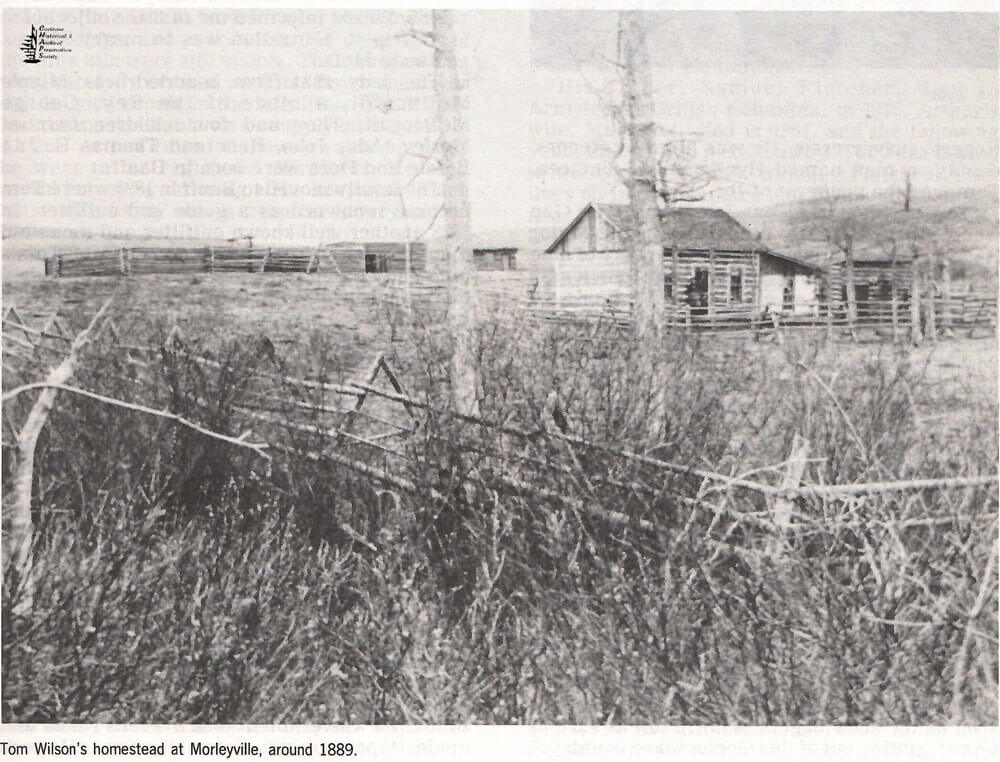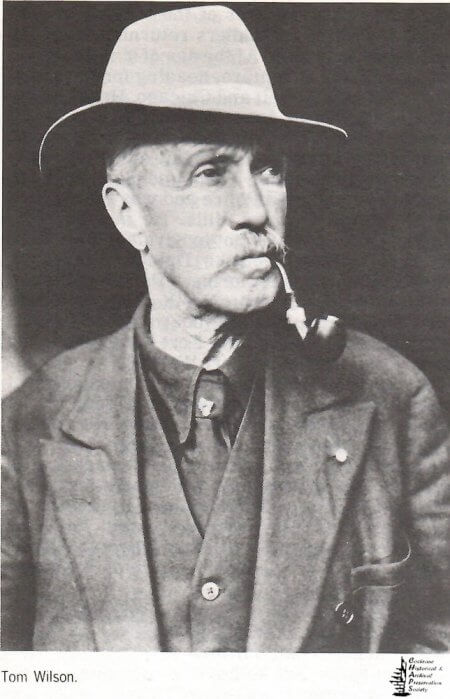by Jean L. Johnson pg 97 Big Hill Country 1977
One of the best-known characters to live in the Morleyville Settlement, in the early days, was Tom Wilson, though he is more widely remembered as a guide and outfitter of Banff, where he moved in 1893. For a time, in 1881 and 1882, he worked with survey parties planning the route of the C.P.R. through the mountains.
Pierre Berton, in his book The Last Spike Vol. 2 of The Great Railway), describes in dramatic detail how Tom Wilson saved the engineer, Major A. B. Rogers, from drowning when he made a foolhardy attempt to ford a swift and swollen stream, in July of 1881. This stream, which flows into the Bow River from the Daly glacier near the eastern end of the Kicking Horse Pass, has been known ever since as Bath Creek. This occurred before Rogers had discovered the pass through the Selkirks which bears his name, so it is quite possible that had Tom failed to pull the Major from the icy waters, the railway would have followed a different route and the subsequent development of Alberta and eastern British Columbia might have taken a very different course.
Tom Wilson was born at Bond Head, forty miles north of Toronto, on August 21, 1859, of pioneer stock. Like many Ontario farm boys, he had read romantic tales of the Northwest and heard the yarns of soldiers returning from the Red River Rebellion. At the age of sixteen, he set out looking for adventure, heading for the Canadian West, via Detroit and Chicago. He got as far as Sioux City, Iowa when a surge of homesickness sent him home again. However, four years later the urge for adventure was strong in him again. This time he joined the North West Mounted Police and was sent to Fort Walsh in the Cypress Hills. He started from Barrie, Ontario, and went to Sarnia. From there he went by steamboat to Duluth, Minnesota, where he boarded the Northern Pacific to the end of steel at Bismarck, North Dakota. From Bismarck, he travelled by boat up the Missouri River to somewhere above Fort Benton and then across the prairies to Fort Walsh.
In April of 1881, the talk and the excitement was all of the coming railway and Tom Wilson felt he had to be part of the action. He applied for, and was given, his discharge from the Mounted Police and took a job as a packer with the I. G. Baker Company, which had a contract to supply the party searching for a route through the mountains. He proceeded south with the freight company to Fort Benton where there was a wait of a week, for the arrival of Major Rogers’ survey crew. He was hired by Rogers’ deputy, a man named Hyndman. At nineteen, Tom was the youngest of the crew.
The party started out for Bow River Gap where they were to rendezvous with Major Rogers. It took three weeks for the party of nine prairie schooners, pulled by twenty-four teams of horses, as well as eighty pack animals, to reach Old Bow Fort. Crossing the Old Man River at Coalbank, (now Lethbridge) they had to convert the wagons into boats. When they reached Fort Calgary, they found some semblance of civilization – four log buildings: Mounted Police Barracks, Hudson’s Bay Post, I. G. Baker store and a mission. They left Fort Calgary on July 5 and camped that night on Big Hill Creek, at the site of the present town of Cochrane.
Here they were joined by Rev. John McDougall, the Methodist missionary, who offered to guide them, as the wagon trail ended at Morley. From there west there was only an Indian [sic] trail. At Bow Fort, where the Baker Company’s contract ended, they pitched camp, and next day, Sunday, heard a sermon by Rev. John McDougall who took for his text, “As sure as Christ.” This was not taken from the Bible but from the words of a Montana packer: “Just as soon as the snow begins to fall, I am as sure as Christ, getting out of this Godforsaken country.”
Tom became a great friend of Major Roger who wanted him to go on foot alone to explore Howse Pass. Tom quit. Later, guiding for the C.P.R., he discovered Lake Louise. The next he again met up with Major Rogers and he did explore Howse Pass. He was the first white man to view Takakkaw Falls in Yoho Park where later, a bronze plaque was erected in his honour.
The fall of 1882 he left the mountains and spent the winter with Mr. and Mrs. David McDougall at Morley. Possibly it was about this time that he built the little log cabin on land taken later by James Potts.
In April 1885 he received a wire from Maj Steele asking him to join Steele’s Scouts organized to assist in putting down the Riel Rebellion. When the rebellion was over he returned to Morley and homesteaded the SW 29-26-6-5, on the School Section west of the James Potts place. His buildings are long gone but there is a spot in a hollow up on the School Section hill that shows some faint signs of human abode. And there one day, I discovered rhubarb growing among the grass. During the three years, we lived on the old Coleman place, I went up regularly to pick the stunted stalks. Strangely enough, I discovered Tom’s rhubarb the year he died.
From Frank White’s Diary: “Sept. 29, 1885, Wilson informed me that the object of his trip to Edmonton was to marry Miss Minnie McD.”
The lady that Tom married was Minnie McDougall, a niece of the Rev. George McDougall. They had four children born at Morley, Ada, John, Rene and Thomas E. Jr.; Bessie and Dora were born in Banff.
The family moved to Banff in 1893 where Tom became renowned as a guide and outfitter. In 1898 another well-known outfitter and mountain man, Jimmie Simpson, became one of Tom’s men and cooked for him on the trail when they took a party of Philadelphians into Emerald Lake, another lake which had been discovered and named by Tom.
About 1901 Tom Wilson established a horse ranch on the historic Kootenay Plains. This beautiful ranch was on the flats of the North Saskatchewan River, surrounded by mountains. The plains were rich in hard grass and were swept by Chinook winds in winter so that there was excellent winter range and no cultivation of the land was necessary. Tom had A fences and good log buildings and corrals close to the river. He packed his water up from the river with a yoke across his shoulders. This yoke was carved from a log and a pail was hung from each end, making the load very easy to carry.
Tom wintered his horses on the Kootenay Plains and in the summer took his saddle horses and pack horses to Banff where he carried on as an outfitter and had a pony stand at Lake Louise. In 1919 the Government took over his ranch and made it part of the Forest Reserve. He was
forced to part with his Powder Horn horses which had greatly increased in numbers. Frank Wellman bought the horses.
Tom Wilson went back to Banff and his beloved mountains. There he worked for the C.P.R. giving information to the tourists. He became a Justice of the Peace in Banff and there on September 20, 1933, he died. The bronze plaque was brought from the Yoho and placed over his grave in Banff.
More reading



